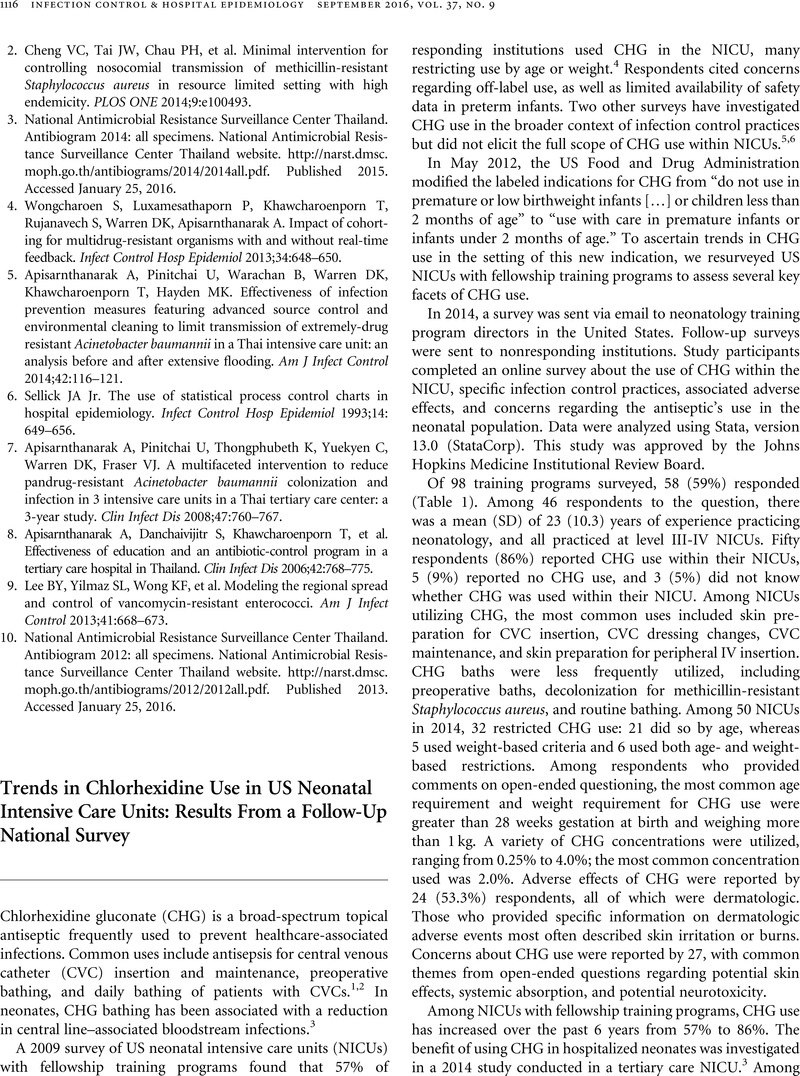Crossref Citations
This article has been cited by the following publications. This list is generated based on data provided by Crossref.
Sharpe, Elizabeth
Kuhn, Latoya
Ratz, David
Krein, Sarah L.
and
Chopra, Vineet
2017.
Neonatal Peripherally Inserted Central Catheter Practices and Providers.
Advances in Neonatal Care,
Vol. 17,
Issue. 3,
p.
209.
Vanzi, Valentina
and
Pitaro, Rosanna
2018.
Skin Injuries and Chlorhexidine Gluconate-Based Antisepsis in Early Premature Infants.
Journal of Perinatal & Neonatal Nursing,
Vol. 32,
Issue. 4,
p.
341.
Janssen, Lisanne M A
Tostmann, Alma
Hopman, Joost
and
Liem, Kian D
2018.
0.2% chlorhexidine acetate as skin disinfectant prevents skin lesions in extremely preterm infants: a preliminary report.
Archives of Disease in Childhood - Fetal and Neonatal Edition,
Vol. 103,
Issue. 2,
p.
F97.
Sommer, Lauren M.
Krauss, Jennifer L.
Hultén, Kristina G.
Dunn, James J.
Kaplan, Sheldon L.
and
McNeil, J. Chase
2019.
The prevalence of antiseptic tolerance genes among staphylococci and enterococci in a pediatric population.
Infection Control & Hospital Epidemiology,
Vol. 40,
Issue. 3,
p.
333.
Mwananyanda, Lawrence
Pierre, Cassandra
Mwansa, James
Cowden, Carter
Localio, A Russell
Kapasa, Monica L
Machona, Sylvia
Musyani, Chileshe Lukwesa
Chilufya, Moses M
Munanjala, Gertrude
Lyondo, Angela
Bates, Matthew A
Coffin, Susan E
and
Hamer, Davidson H
2019.
Preventing Bloodstream Infections and Death in Zambian Neonates: Impact of a Low-cost Infection Control Bundle.
Clinical Infectious Diseases,
Vol. 69,
Issue. 8,
p.
1360.
Johnson, Julia
Suwantarat, Nuntra
Colantuoni, Elizabeth
Ross, Tracy L.
Aucott, Susan W.
Carroll, Karen C.
and
Milstone, Aaron M.
2019.
The impact of chlorhexidine gluconate bathing on skin bacterial burden of neonates admitted to the Neonatal Intensive Care Unit.
Journal of Perinatology,
Vol. 39,
Issue. 1,
p.
63.
Beekman, Karen
and
Steward, Deborah
2020.
Chlorhexidine Gluconate Utilization for Infection Prevention in the NICU.
Advances in Neonatal Care,
Vol. 20,
Issue. 1,
p.
38.
Westling, T.
Cowden, C.
Mwananyanda, L.
Kapasa, M.L.
Machona, S.
Pierre, C.
Mitra, N.
Hamer, D.H.
and
Coffin, S.E.
2020.
Impact of chlorhexidine baths on suspected sepsis and bloodstream infections in hospitalized neonates in Zambia.
International Journal of Infectious Diseases,
Vol. 96,
Issue. ,
p.
54.
Akinboyo, Ibukunoluwa C.
Zangwill, Kenneth M.
Berg, Wendy M.
Cantey, Joseph B.
Huizinga, Beth
and
Milstone, Aaron M.
2020.
SHEA neonatal intensive care unit (NICU) white paper series: Practical approaches to Staphylococcus aureus disease prevention.
Infection Control & Hospital Epidemiology,
Vol. 41,
Issue. 11,
p.
1251.
Kim, Yoon-Joo
Yoon, Young Mi
Kim, Young Ree
Heo, Sang Taek
Yoo, Jeong Rae
Lee, Keun Hwa
and
Choi, Jae Hong
2020.
Group B streptococcal transmission via a prolonged colonizer in a neonatal intensive care unit.
Journal of Microbiology, Immunology and Infection,
Vol. 53,
Issue. 1,
p.
179.
Chopra, Vineet
Janssen, Lynn
Bryant, Kristina
Fauerbach, Loretta
Talbot, Thomas R.
and
Babcock, Hillary M.
2020.
A Process for Assessing Products for Infection Prevention in Health Care Settings: A Framework From the Healthcare Infection Control Practices Advisory Committee of the Centers for Disease Control and Prevention.
Annals of Internal Medicine,
Vol. 172,
Issue. 1,
p.
30.
Johnson, Julia
Akinboyo, Ibukunoluwa C.
and
Schaffzin, Joshua K.
2021.
Infection Prevention in the Neonatal Intensive Care Unit.
Clinics in Perinatology,
Vol. 48,
Issue. 2,
p.
413.
Wendel, Danielle
Mezoff, Ethan A.
Raghu, Vikram K.
Kinberg, Sivan
Soden, Jason
Avitzur, Yaron
Rudolph, Jeffrey A.
Gniadek, Michelle
Cohran, Valeria C.
Venick, Robert S.
and
Cole, Conrad R.
2021.
Management of Central Venous Access in Children With Intestinal Failure.
Journal of Pediatric Gastroenterology and Nutrition,
Vol. 72,
Issue. 3,
p.
474.
Gilmore, Molly
Cole, Alexandra
and
DeGrazia, Michele
2022.
Evidence‐based review of chlorhexidine gluconate and iodine in the preoperative skin preparation of young infants.
Journal for Specialists in Pediatric Nursing,
Vol. 27,
Issue. 4,
Jain, Amish
Deshpande, Poorva
Yoon, Eugene W.
Lee, Kyong-Soon
McGeer, Allison
and
Shah, Vibhuti
2022.
2% aqueous vs alcohol-based chlorhexidine for skin antisepsis in VLBW neonates undergoing peripheral venipuncture: a non-inferiority trial.
Journal of Perinatology,
Vol. 42,
Issue. 5,
p.
636.
Zhou, Jinyan
Mei, Lingli
and
Chen, Shuohui
2022.
Effect of chlorhexidine cleansing on healthcare-associated infections in neonates: a systematic review and meta-analysis.
Archives of Disease in Childhood - Fetal and Neonatal Edition,
Vol. 107,
Issue. 4,
p.
398.
Harrison, Iris S.
Monir, Reesa L.
Neu, Josef
and
Schoch, Jennifer J.
2022.
Neonatal sepsis and the skin microbiome.
Journal of Perinatology,
Vol. 42,
Issue. 11,
p.
1429.
Popovich, Kyle J.
Aureden, Kathy
Ham, D. Cal
Harris, Anthony D.
Hessels, Amanda J.
Huang, Susan S.
Maragakis, Lisa L.
Milstone, Aaron M.
Moody, Julia
Yokoe, Deborah
and
Calfee, David P.
2023.
SHEA/IDSA/APIC Practice Recommendation: Strategies to prevent methicillin-resistant Staphylococcus aureus transmission and infection in acute-care hospitals: 2022 Update.
Infection Control & Hospital Epidemiology,
Vol. 44,
Issue. 7,
p.
1039.
Lompo, Palpouguini
Heroes, Anne-Sophie
Agbobli, Esenam
Kühne, Vera
Tinto, Halidou
Affolabi, Dissou
and
Jacobs, Jan
2023.
Bacterial Contamination of Antiseptics, Disinfectants and Hand Hygiene Products in Healthcare Facilities in High-Income Countries: A Scoping Review.
Hygiene,
Vol. 3,
Issue. 2,
p.
136.
Choi, Eui Kyung
Choi, Byung Min
Cho, Yuji
and
Kim, Suhyun
2023.
Myelin toxicity of chlorhexidine in zebrafish larvae.
Pediatric Research,
Vol. 93,
Issue. 4,
p.
845.





